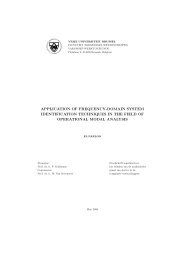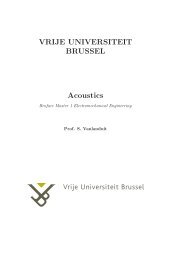IPPAM Intelligent Prosthesis actuated by pleated Pneumatic Artificial ...
IPPAM Intelligent Prosthesis actuated by pleated Pneumatic Artificial ...
IPPAM Intelligent Prosthesis actuated by pleated Pneumatic Artificial ...
- No tags were found...
Create successful ePaper yourself
Turn your PDF publications into a flip-book with our unique Google optimized e-Paper software.
known type is that of the so-called Pleated <strong>Pneumatic</strong><strong>Artificial</strong> Muscle (PPAM) [21], [22] shown in Figure 9.characteristic properties that can be inferred from thementioned experiment are: (1) a loaded PPAM contracts whenthe internal pressure p is increased, and (2) a loaded PPAMshortens <strong>by</strong> increasing its enclosed volume V.A second experiment is shown in Figure 11. The mass M isgradually reduced whilst the internal pressure p is kept at aconstant value. In this case the muscle will swell up andthere<strong>by</strong> shorten. If the mass is completely removed, asdepicted in configuration (c), the muscle reaches its minimumlength, l min , and maximum volume, V min . The pulling force hasnow dropped to zero. This implicates that: (3) a PPAM willshorten when its load is decreased, and (4) there exists anupper limit at which the PPAM no longer generates a pullingforce and the enclosed volume is maximal.Figure 9: 3 contraction levels of a PPAM [25]The core element is a flexible reinforced membrane, at bothends attached to fittings along which mechanical power istransferred to a load. As the membrane is inflated or gas issucked out of it, it is bulged out or squeezed, respectively.Related to this radial expansion or compression, the membranecontracts or stretches axially and exerts a pulling force on itsload. Like already cited the PPAM’s energy source is air. Thatway the actuator is powered <strong>by</strong> the pressure differencebetween the internal air and the ambient air. To see andunderstand how a mechanism – in casu a PPAM plus externalload – works, two setups will be considered.Figure 11: PPAM at constant pressureInterpretation of the PPAM behaviour within the twomentioned experiments uncovers a contrast to the behaviour ofa pneumatic cylinder: the force that can be generated <strong>by</strong> apneumatic cylinder only depends on pressure and pistonsection implying that at a constant pressure, the force remainsconstant independent of the piston displacement.The pulling force, exerted <strong>by</strong> the PPAM, can be derivedmathematically and set as:F2L= p. L0 . f ( ε,, a)(1)RFigure 10: PPAM at constant loadFigure 10 depicts the working mechanism of a PPAM atconstant load. Within this experiment the increase of internalair pressure from zero to p 2 results in a changing musclelength l and enclosed volume V. At zero gauge pressure(configuration a) the muscle has its minimum volume, V min ,and its maximum length, l max . If the muscle is pressurized top 1 , it will start to swell up and generate a pulling forcesimultaneously. The mass M will thus be lifted just until thegenerated force equals the gravitative force Mg. Now themuscle length and muscle volume have changed to l 1 and V 1respectively (configuration b). Further increase of the internalpressure will continue this process (configuration c). Thein which p represents the internal air pressure in the PPAM, L 0its full length, ε its momentary contraction, R its minimumradius and a a dimensionless factor which takes account of themembrane’s elasticity. If this membrane consists of hightensile strength and stiffness material, the influence ofelasticity can be dropped and set to zero. Now, one can seedirectly that f is a dimensionless function, depending only onthe contraction and slimness of the muscle. Using L 0 = 110mm and R = 11.5 mm, results in the theoretical forcecharacteristics visualized in Figure 12.4
















